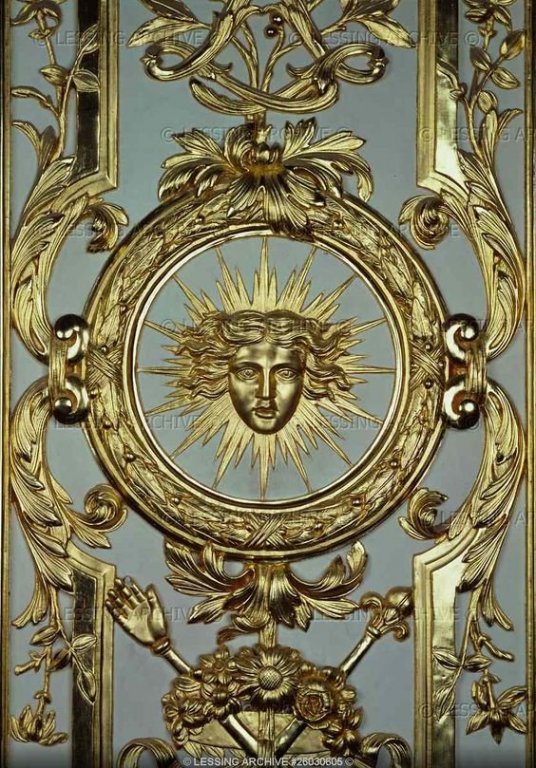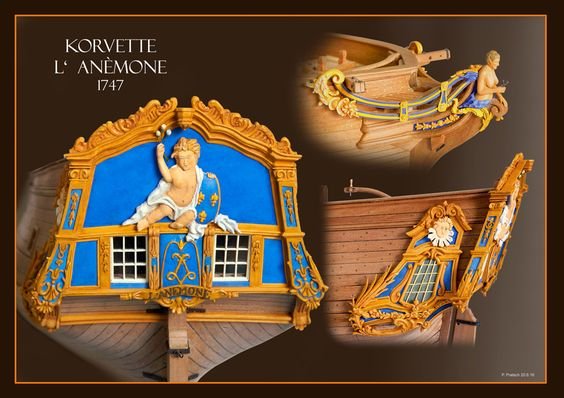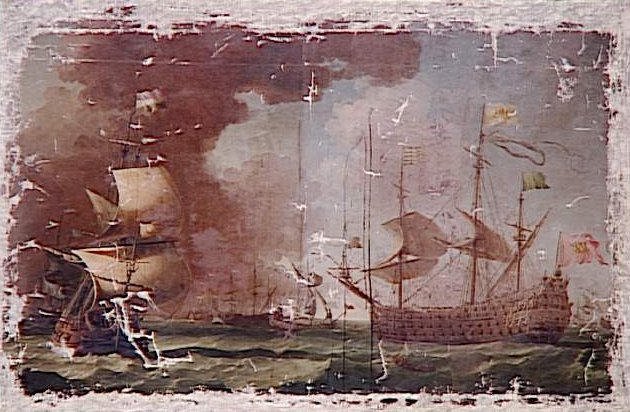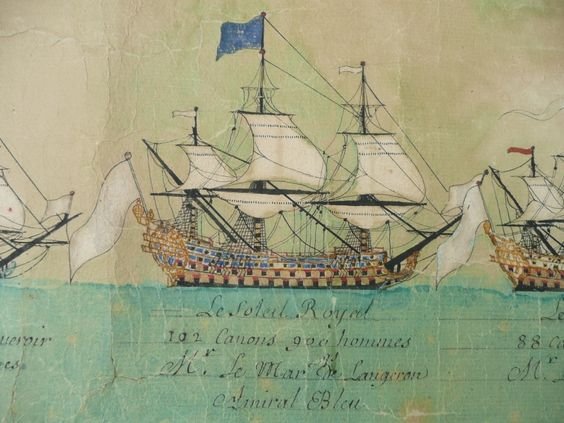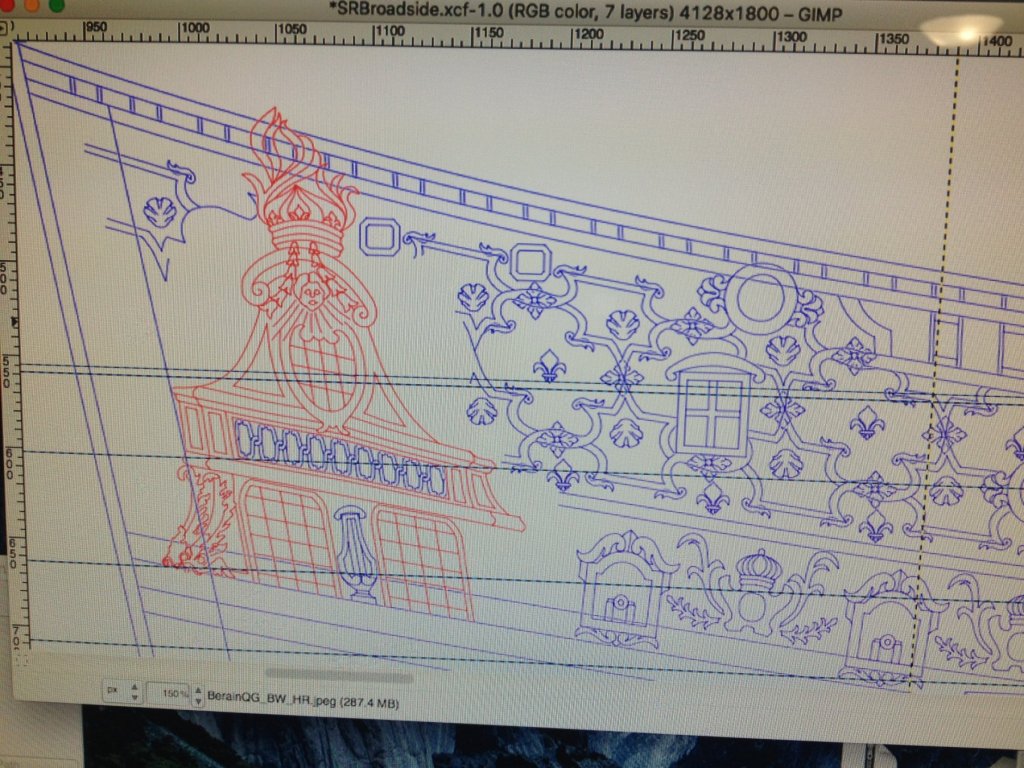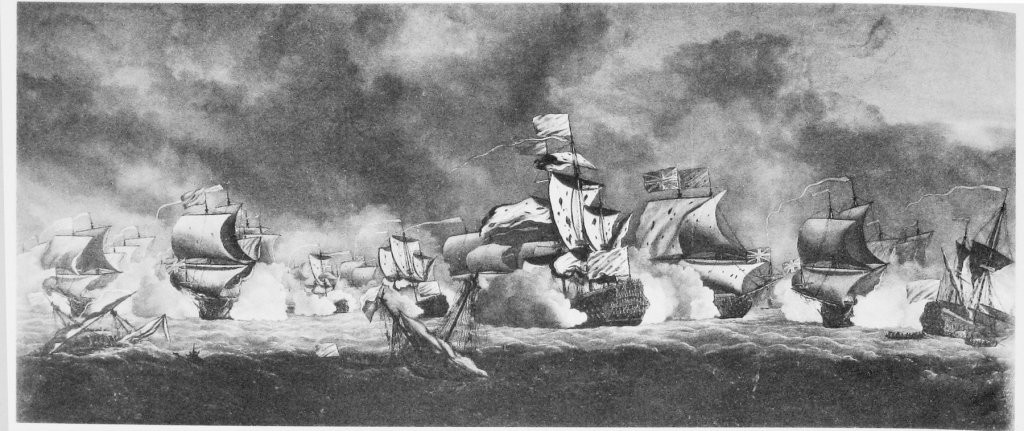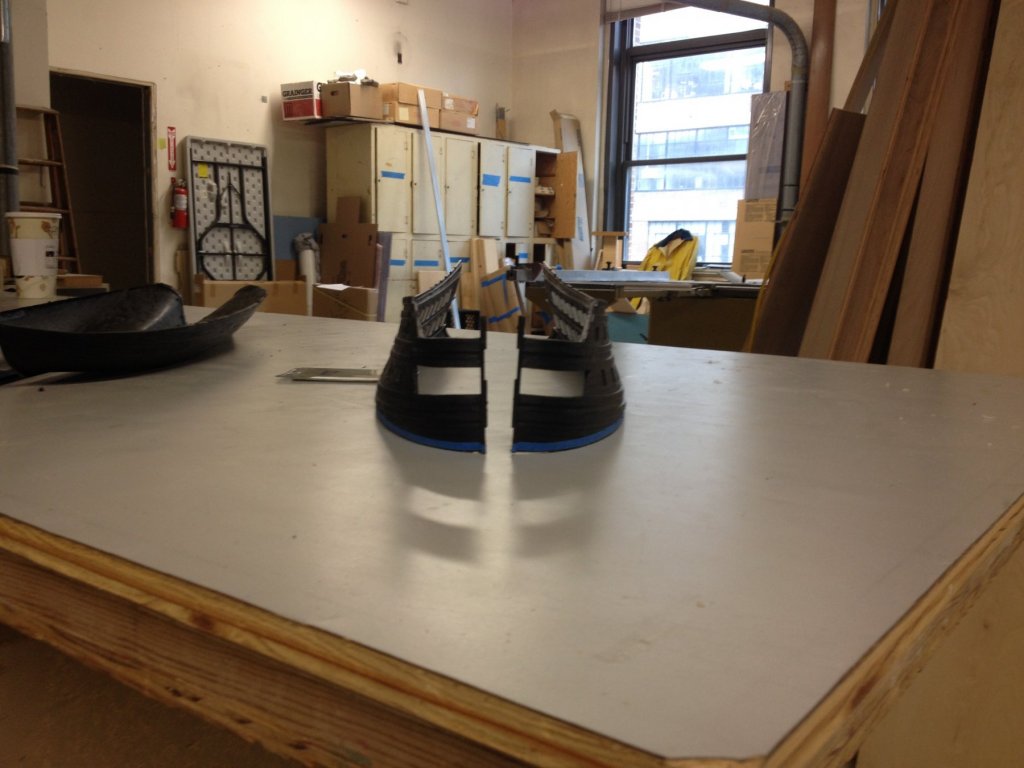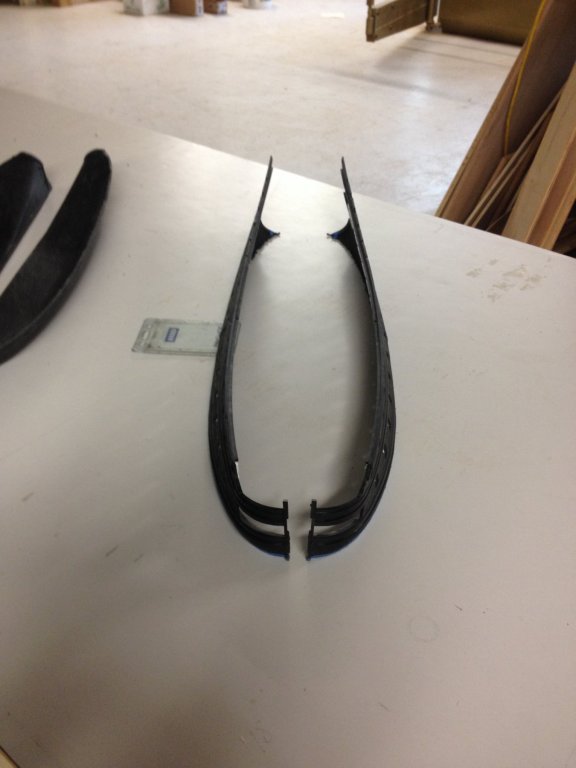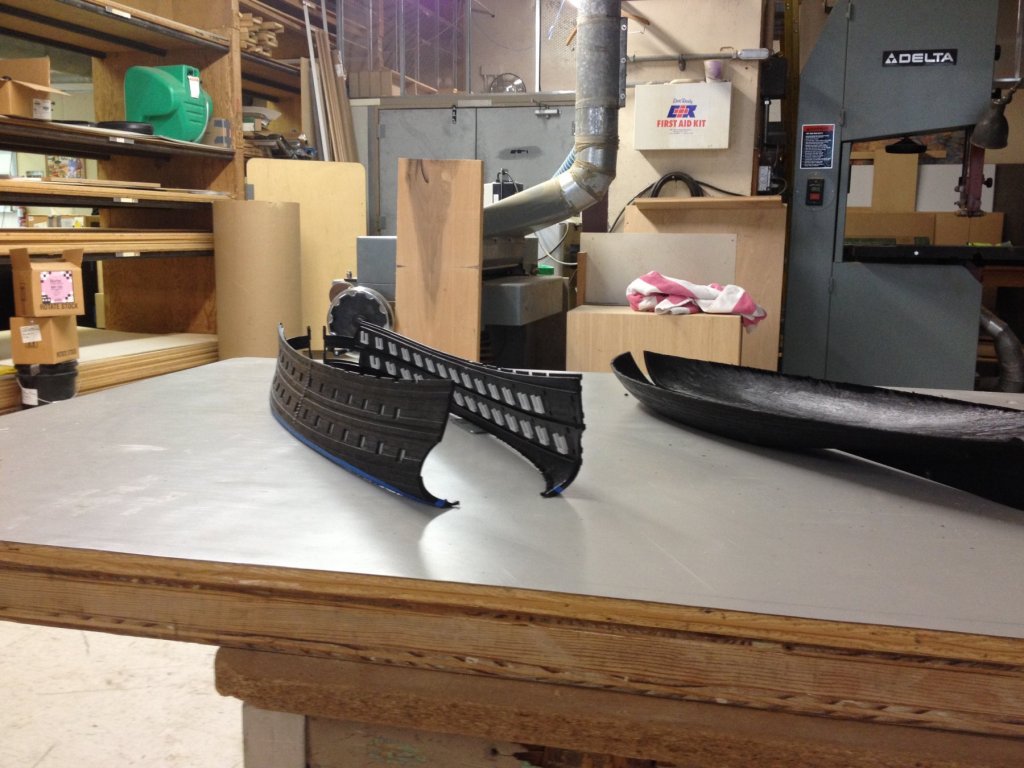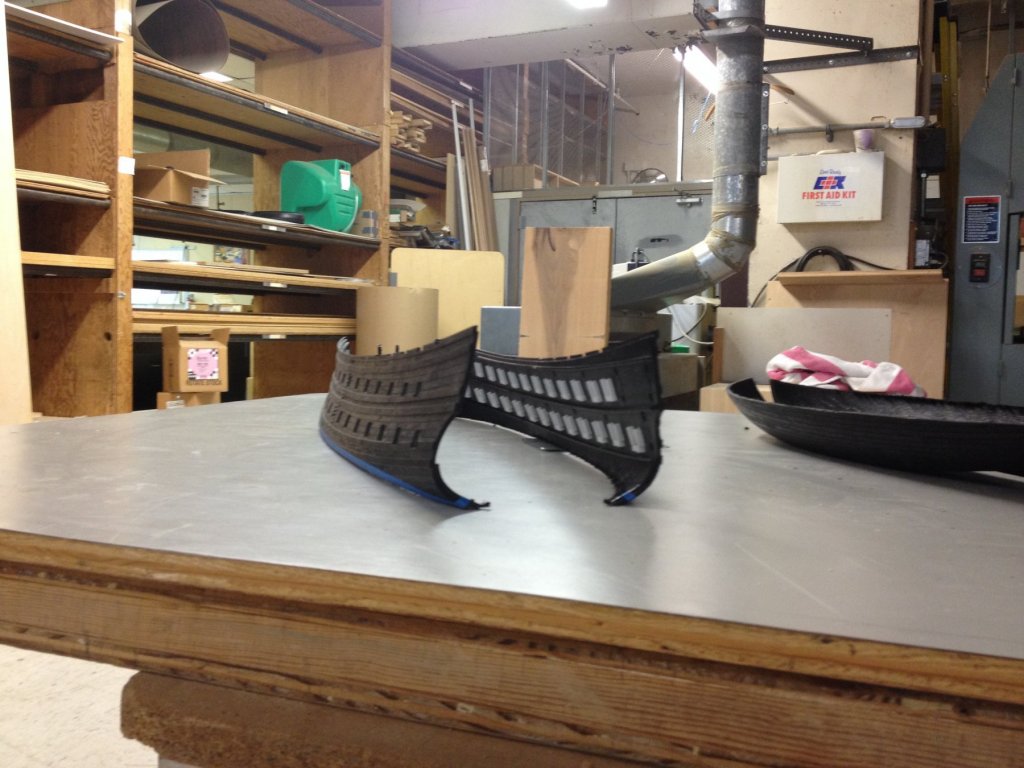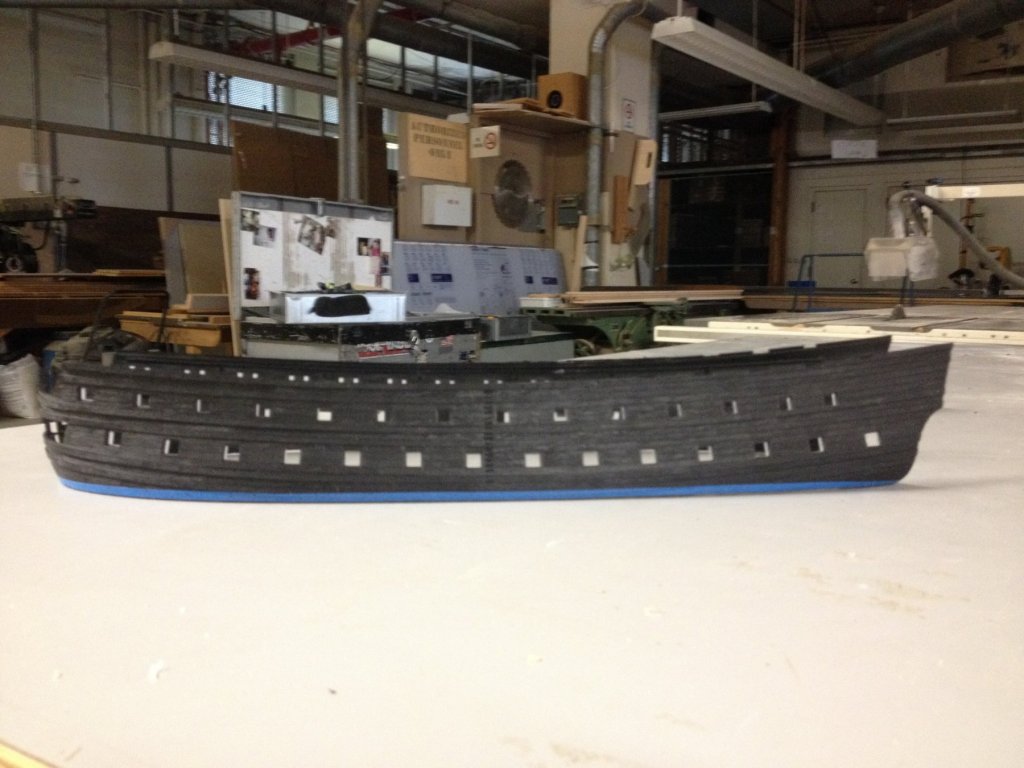-
Posts
2,982 -
Joined
-
Last visited
Content Type
Profiles
Forums
Gallery
Events
Everything posted by Hubac's Historian
-
I haven't made my mind up about this completely yet, but at first I was liking this muted grayish blue from Versailles, as the primary blue, with ultramarine accents on select areas of the stern quarters and tafferal: I think the gilt work shows up really nicely against this color. But, then, I saw this model and it got me to thinking about the way this brighter, light blue plays against the yellow ochre: I really like this as a primary combination, where most of the panel framing would be in this yellow ochre, while reserving the gilt work for the large and important figurative carvings and certain essential accent carvings, i.e. anything that directly references the sun, or the Sun King, himself. In this scheme, I would still use Ultramarine blue as a secondary, accent color. This second approach may or may not be accurately reflective of what was being done at the time, but artistically, I just like it.
- 961 replies
-
The question of what shade of blue would be appropriate is a difficult one to answer. The deep, ultramarine blue which was made from pulverized lapis, would have been exhorbitantly expensive to make, and so in my opinion - I believe it would have been present on SR, but used selectively, as an accent color. Most of the upper bulwarks, I believe would he a lighter shade of blue. Given SR's special status within the fleet, however, it is possible that they spared no expense and did her whole upper works in ultra-marine blue. In the absence of more in-depth research, I don't think there is a completely right or wrong answer. For guidance, though, one can look to the restored interiors of Versailles, which presumably, would be painted in shades that mimic period colours. The most I could determine, so far, was that other shades of blue could be more cheaply produced from oxides of copper. Later, when I get home, I'll post a pic of a colour scheme that I personally like and plan to use.
- 961 replies
-
So, here are another two interesting little bits of ephemera that I found on the same site that Michel Saunier primarily posts his build-log for SR: I have no idea, what this top image actually represents: whom the artist was that created it, whether this badly degraded print is some kind of postcard of a larger, original work, or of course, what ship is actually represented here. It does appear to be a French ship. It is pierced for sixteen ports on the first battery. It does not seem to correspond with La Reyne, as there do seem to be three tiers of stern windows. Interestingly, this is one of only a very few images of early French ships that show any substantial raking of the main mast. Could this be Soleil Royal, numero uno, at some point before her demise in 1692? Can anyone shed light on what this image is in reference to? The second image is a line of battle schematic of the French ships involved in the Battle of Malaga, in 1704. The SR pictured, as I understand it, is the ex Foudroyant of 1693. This is not terribly useful, for my purposes, although it is interesting to note the blue upper bulwarks and the stern galleries on the main and quarter deck levels, only - perhaps in emulation of the post-refit SR of 1689? Admittedly, that is all a stretch of plausibility! --- In actual build work, the project is moving along nicely. Wale scarfs are scribed, scarf bolting is under way, as is re-location of the aft most port of the first battery, which I am moving forward 3/16" in order to make a little extra room for the lower finishing. So far, I've successfully closed in the aft portion of each port with sheet and strip styrene, and now I need to carve in the new forward half of the port into the kit styrene. It has been interesting to me how the old plastic sands and scrapes; although it still seems plenty flexible, it is quite hard and sort of thready when you sand or scrape it. I don't remember that being the case with the first SR I built, but that was a later pressing from the 80's, under the IMAI brand. I'll post a few pictures in the near future, perhaps after I've gotten those two ports moved and fully reconstructed, and after I've re-shaped the lower transom profile, in order to accommodate the new round-up of the stern.
- 2,463 replies
-
- heller
- soleil royal
-
(and 9 more)
Tagged with:
-
I am 100% in agreement; we have to find which methods work for us, that give us good results wihout too much headache. If it isn't fun, then why bother, right?
- 2,463 replies
-
- heller
- soleil royal
-
(and 9 more)
Tagged with:
-
Hello hjx, Thank you for taking the time to visit my build log. Your kind words are greatly appreciated. To my mind, and spanning roughly 100 years from the 1660s, onward, the French were responsible for creating the most artistically interesting ships, and then as ship design moved into the next epoch, and ships became flatter, the French were responsible for creating some of the most widely emulated naval architecture of any of the great sea-faring nations. As you can attest with your own projects, hjx, the French are an almost limitless source of compelling subjects. Now that I have returned to the hobby after a pretty long hiatus, it is really fascinating to me how modelers have adapted technology to make better models. You, for example hjx, are using Zbrush (full disclosure: I'ma have to look that up) to create 3D models that can be refined within the software and then fed to a CNC machine. The roughed blank is, artisitically, a much better starting point than most of us would be able to achieve if we had to do all of that wasting by hand. But what was really interesting about your figurehead, hjx, was that your manipulation of the 3D model seemed to make her appear like a more youthfull version of herself; if only plastic surgery could have this do-it-yourself-at-home user friendliness! Anyway, I will continue to watch what you are doing with great interest, as there is much for me to learn there.
- 2,463 replies
-
- heller
- soleil royal
-
(and 9 more)
Tagged with:
-
Well, Mark, I wonder the same thing, and despite my experiment in deleting path objects (and even saving the revised copy of the document after deleting, which didn't seem to help) I suspect that this very issue is the crux of the problem. By the time I finished with the frieze and started the quarter galleries, I had already noticed a bit of a delay in processing, but it was not at all severe. But then, very abruptly, functionality just seemed to shut down completely. I like your idea for a work-around, Mark. If that solves the problem, I will make it work. Ideally, I would like to publish a complete drawing for the project, but really for the purposes of this build, I really only needed an accurate layout for the frieze (which I have) the QG (30% complete) the stern and bow angels (got them - made them less haggard looking, BTW). I will keep at it, though, and see if I can correct my mistakes. Thank you for weighing-in, Mark!
- 2,463 replies
-
- heller
- soleil royal
-
(and 9 more)
Tagged with:
-
Increasing the work space didn't help either. It dawns on me, just now though, that maybe I need to decrease the workspace so that my scanned JPEG pops up more closely to 1:1 scale. As I recall, when I first created this document, one of the first things GIMP wants you to do is establish the size parameters of your workspace. Not knowing any better, I picked a rather arbitrary size that, on the ruler scale, was bigger than the paper my original drawing was on, and then I imported the scanned image as a JPEG into it's own layer. Maybe I just made the workspace too big, in the first place, and that is now compressing my image into too small an area. I'll do another experiment to see if that helps any. Of course, I am open to all suggestions from the more computer saavy contingent, out there. Although, I'm sure I have done several things wrong to Eff this thing up, I believe (hope) what I've done so far is salvagable. I really don't want to start the whole drawing over again in a different software package. I've seen modelers like NekO use GIMP to draft their plans successfully, so I know it is possible. In the meantime, though, I have begun detailing the lower hull halves so that the project is at least moving forward. At the moment, I'm scribing scarf joints, at appropriate intervals, into the wales and am pleased with my engraving, so far. I'll putty-in the original moulded butt-joints. Then, I'll proceed with the myriad other detail additions: carriage tackle through-bolts, the anchor sweep timbers at the bow, simulated treenails, skids, scuppers, etc. I'll post some pics when there's some substantial progress to see.
- 2,463 replies
-
- heller
- soleil royal
-
(and 9 more)
Tagged with:
-
I tried a number of experiments to see whether I could identify the problem. First, I closed my working document and opened a new, blank workspace in GIMP. My thought was to see whether it was a problem within the document I created, or a computing problem with my relatively old MAC from 2007. Although I'm running the current operating system, and I've maximized the machine's RAM, I thought that perhaps the computer was struggling, now, to complete this exercise of connect the dots. In the new document, however, I was able to easily create nodes with extracted handles, and I was able to move them and manipulate their curves instantly. Stroking paths was also instantaneous. So, it would seem, the computer isn't the issue. Next, I made a separate copy of my master document, and I went in and deleted all un-necessary paths that weren't directly connected to, or adjacent to the quarter gallery path object; so, the upper bulwark frieze, the gunports, the sheer railing, the acanthus escutcheons, the filligree between the knees of the head - all of these path objects, I'm calling them, containing many thousands (at this point) of nodes were deleted. The thought, here, was that perhaps the program becomes sluggish when you add too many nodes, as this use of the program (line drawing using the Bezier path tool) is not the primary intended use of the software. Photo manipulation is what GIMP was primarily designed to do. I was sure that deleting all extraneous paths - even if it meant creating multiple isolated documents, representing various areas of the design (quarter gallery, stern, bukwark frieze, etc), would restore the utility of the Bezier path tool. It did not. Still 4-5 second lag times. Finally, I thought that increasing the size of my workspace and the layer images might provide a bigger, more manageable area for these many thousands of nodes to reside in. As it stands, when I open my drawing, what appears is a very small (about 1/4 the intended scale) image of my drawing, which I then zoom-in on to work at. I have found that a 78.5% zoom provides the exact 1:1 scale that I need for my drawing. When I post images of my drawing, this is what you are looking at - a 78.5% zoom. .. Break over - will post this and more to follow.
- 2,463 replies
-
- heller
- soleil royal
-
(and 9 more)
Tagged with:
-
Hey Dan, Your illustration of the paralax issue is made quite well, with these examples from the Sussex build, and the point you are making is well received. With regard to the black and white Berain drawing that I am using as the basis for my quarters and the bulwark frieze, it is difficult to say how literally one should take the drawing because there are a number of similar perspective issues that seem a little screwy; was this drawing a proposal for the ornamentation, or a portrait of the actual ship? No one seems to have an answer to that. Personally, I suspect that it is a proposal drawing and that the ship, as actually fitted out, probably differed according to the practicalities of applying ornament to the necessary architecture of the ship. We'll never know, unfortunately. As a general rule of thumb, though, I agree that the model builder should err on the side of designing a plan with complete port frames, as an example. Progress on my drawing has stalled, for the time being. I was making great progress with the quarter gallery drawing, but as I got to the two pair of dolphins that flank the two main deck windows, my ability to add nodes, to move them around and manipulate curves with the bezier handles slowed down dramatically. Suddenly, I could no longer create a node with handles already extruded, by simply click/hold/dragging the cursor, as before. Now, new nodes were just simple nodes without handles. The only way I could extract handles was to pull on the line between nodes, and even then nothing happened without click/drag/holding the cursor for four to five seconds. If I want to move a node - same thing: 4-5 seconds. Obviously, that makes the process of drawing anything incredibly cumbersome. ... I'll finish this post on my break, but I'll post this much now so I don't lose it.
- 2,463 replies
-
- heller
- soleil royal
-
(and 9 more)
Tagged with:
-
As expected, with Jan being the English equivalent of John. 'Never hurts to ask, though. Cheers! - Marc
- 487 replies
-
- ship of the line
- 80 guns
-
(and 1 more)
Tagged with:
-
There was also another volunteer named Jan, who was a specialist with computers.
- 487 replies
-
- ship of the line
- 80 guns
-
(and 1 more)
Tagged with:
-
Yes, it is sad about the Provincien Project. I had hoped to bring my family to the Werf for the launching of the ship. Had it not been for the determination of Willem Voss, neither the Batavia nor the Provincien would ever have seen the light of day. In my mind, Mr. Voss is a sort of courageous figure like Anders Franzen was for Sweden. To Jan: might you have been someone I was acquainted with, back in '03? As I recall, the Director of the Werf at that time was a very tall man named Jan, and Willem's son was also named Jan.
- 487 replies
-
- ship of the line
- 80 guns
-
(and 1 more)
Tagged with:
-
Hello Drazen, As I read through your build log, I was tempted to hit the "like" button on every post, but thought it might be better to express my admiration in a single post. So much of what you are doing here: filling between the bulkheads, the use of false wales as placeholders, your layout and spiling of the planking - it all seems fresh and innovative to me. And then, to top it off, the quality and standard that you are working to is truly very high. All of your lines appear fair to my eye, and you have achieved a beautiful hull form. I will be following along with great interest. The Provincien holds a special place in my mind and heart. It was 2000, when I first realised that the people at Batavia Werf, under the direction of Willem Voss, were building a highly authentic replica of the ship. I spent the next three years working a second job to save money so that I might go there and "have a hand" in the building of the ship, as a volunteer. By the time I got there in the summer of 2003, the project was stalled as the directors debated a significant re-design of the "spiegel," or mirror shape of the stern. Initially, the framing did not indicate the tumblehome of a warship of that period. The decision to scrap and re-build the transom was a significant one, and was not to be resolved in the three months I spent there. I did, however, spend those three months fully engaged with what were for me, at that time, extremely challenging maintenance projects on the Batavia. In short, those were three of the most fullfilling months of my life as I did exactly what My dream job would be. I met so many great people at the Werf, who did so much for me and took me under their wings, despite my admitted social awkwardness, at that time in my life. I left Holland feeling that the Dutch people were as warm and genuine as those that I had met on trips to Ireland. One of the people I sought out, while I was there, was Herbert Thomesan. I went to see him at his shop and he showed me quite a lot about the construction of his Texel Roads diorama - which as anyone who has seen it can attest, is absolutely mind-blowing in its scope and attention to detail. I found Mr. Thomesan to be an enormously talented person who was very generous with his knowledge and insight. I owe much of what I'm doing (or, at least in the planning stages of doing) today to him. So, Drazen, I look forward very much to seeing your Provincien rise from the stocks! With luck, the replica project will find the funding they need and work will soon resume, if it hasn't already.
- 487 replies
-
- ship of the line
- 80 guns
-
(and 1 more)
Tagged with:
-
Hey Dan, Great progress and an interesting post! This area on the Lido deck, with the stairwell enclosure: I'm afraid I don't have any solutions, but more questions. The symbol they are using to indicate the swing of the doors on three sides of the srairwell enclosure also appears on the inside face of the outer bulwark. If it's a door, in one instance, what does it represent in the other? Also, from one stairwell enclosure to the other, the inner pair of double doors is shown to have opposing-handed doors on the port side, while on the starboard side, both doors swing into the enclosure: why wouldn't the arrangement be symetrical? As for the dashed versus the dotted line, perhaps the dashed line indicates the run of an interior bulwark on the Lido deck, which is covered over by the Promenade deck? Did the shipyard that constructed her, build a sister or near-sister in the same time period? Perhaps pictures exist of the stern of a similar ship that might shed light on these issues.
- 287 replies
-
- michelangelo
- ocean liner
-
(and 1 more)
Tagged with:
-
She's truly magnificent, EJ! A satisfying endgame to a job well done.
- 608 replies
-
- la couronne
- corel
-
(and 1 more)
Tagged with:
-
Great start to the transom, EJ. You were right to shorten the height of the chase ports; it will make a big difference in the finished model.
- 961 replies
-
Last night, I went to visit Dan Pariser who very graciously invited me over to discuss my project. After offering a number of helpful tips and suggestions, Dan brought out his recently acquired, two-volume boxed set of the collected paintings of the Van de Veldes, by M.S. Robinson. Upon looking up SR in the index, I discovered the above thumbnail of a large (4'x8') painting of The Battle of Barfleur. I had never seen this painting before, and was immediately intrigued because it features SR, from her port quarter, facing off against Britannia. Here is a close-up of her stern detail: Upon publication of these twin volumes, it was noted by Robinson that the painting was housed in a private collection at Euston Hall, in Sussex. The painting is not directly attributed to either the Elder or Younger VDV, but is believed to at least be a product of their studio. Later, last night I sent an inquiry to Euston Hall, and the curator responded, promptly, this morning. She told me that, in her time there, the painting had not been in residence and that she was not familiar with it. My next move will be to contact the National Maritime Museum in Greenwich to see whether they have it in their collection, or know its whereabouts. I am hopefull that they, or some private owner, can ultimately provide me with a high-res close-up of SR. Given the rather large size of the painting, this small thumbnail suggests that there is quite a bit of detail painted into the portrait, which may be insightful under magnification. My internet image searches have turned up exactly zero results connected to this painting, so I suspect that it has not changed hands often, and as a result, there are few photographs of the work in the public realm. That the work is attributed to the VDV studio lends the image of SR a degree of credible authenticity that is more or less suspect at the hands of other contemporary marine painters. I am sending this out to the MSW community in the hope that some of you may be familiar with the painting, know where it is housed, or even possess some better imagery of the painting that they can share. As always, any help along these lines is greatly appreciated, as are any visitors to my page, for taking an interest in this project. And special thanks to you Dan, for availing me once again, of your hospitality, insight and resources. Thank you, Marc
- 2,463 replies
-
- heller
- soleil royal
-
(and 9 more)
Tagged with:
-
The re-work really adds up, EJ, but it is well worth the effort. You will always rest easy knowing you did what was necessary. Can't wait to see the finish planking begin!
- 961 replies
-
Hopefully she'll be closer to bride of Frankenstein than Frankenstein, himself! I'll aim a little higher and hope for the best.
- 2,463 replies
-
- heller
- soleil royal
-
(and 9 more)
Tagged with:
-
One thing Cedric has pointed out, with his build of La Reyne, and which becomes much more apparent with the hull cut down, is that the sheer of the wales at the bow rises too sharply. In fact, the sheer at the bow should be flatter and more closely to parallel with the waterline, only rising sharply aft of the main channels. Cedric, I believe, will be making efforts to correct this flaw because he is re-positioning all of the port locations to correspond with 16 port openings per side, on the first battery. This is one issue I will reserve for the future scratch build. It bothers me, somewhat, but not nearly enough to go to all the trouble of correcting it.
- 2,463 replies
-
- heller
- soleil royal
-
(and 9 more)
Tagged with:
-
And so, the long slow journey begins and there's no turning back now! I had the opportunity to get into the shop early, before work began today, and I cut away the bottom of the hull on the bandsaw. The blue tape indicates the raised waterline by 3/16". The instant you cut away the lower hull, IMO, this becomes a much better model. Here, I'm showing the hull halves separated by the 1/2" I will be adding at the stem. The distance across the transom was approximated by eye, but that is very close to what it will be. I'm making a long sanding block to flatten out the waterline. Once I do, these hull blanks should stand with their stem pieces perfectly parallel to each other. I'll be saving the lower hull pieces in order to experiment with my treenail and through bolt simulations, as well as for working up a layered paint protocol that will simulate the look of wood on the water, but not overly weathered. As this is a diorama model of the ship, shortly after her re-fit in 1689, I am thinking about placing her at anchor, on the Penfeld river with the Brest Arsenal towering in the near distance, the morning sun rising to illuminate her gilt work and Tourville on a launch, being rowed out to take comand of his ship. Next week, I go on vacation, and I may bring the blanks with me to start detailing. Substantive updates like this will be slow coming, because I will still work on the drawing when I can. But this is a start, anyway.
- 2,463 replies
-
- heller
- soleil royal
-
(and 9 more)
Tagged with:
-
A well deserved victory lap, Ken! I have really enjoyed all of the care and attention you have taken to clean up the castings, as well as your re-working of the stern gallaries, in order to make everything line-up properly. This really is turning out to he a magnificent model.
- 424 replies
-
Hi Ken, I've been meaning to ask you for some time about what particular gold paint you are using, so I am glad to know what that is now. But I also like your sepia tone distressing. Is that also a Tamaya acrylic based wash, or some other brand? And how much must you dilute it to get these results, which really pick out the creases and crevasses, without muddying the gold?
- 424 replies
About us
Modelshipworld - Advancing Ship Modeling through Research
SSL Secured
Your security is important for us so this Website is SSL-Secured
NRG Mailing Address
Nautical Research Guild
237 South Lincoln Street
Westmont IL, 60559-1917
Model Ship World ® and the MSW logo are Registered Trademarks, and belong to the Nautical Research Guild (United States Patent and Trademark Office: No. 6,929,264 & No. 6,929,274, registered Dec. 20, 2022)
Helpful Links
About the NRG
If you enjoy building ship models that are historically accurate as well as beautiful, then The Nautical Research Guild (NRG) is just right for you.
The Guild is a non-profit educational organization whose mission is to “Advance Ship Modeling Through Research”. We provide support to our members in their efforts to raise the quality of their model ships.
The Nautical Research Guild has published our world-renowned quarterly magazine, The Nautical Research Journal, since 1955. The pages of the Journal are full of articles by accomplished ship modelers who show you how they create those exquisite details on their models, and by maritime historians who show you the correct details to build. The Journal is available in both print and digital editions. Go to the NRG web site (www.thenrg.org) to download a complimentary digital copy of the Journal. The NRG also publishes plan sets, books and compilations of back issues of the Journal and the former Ships in Scale and Model Ship Builder magazines.



